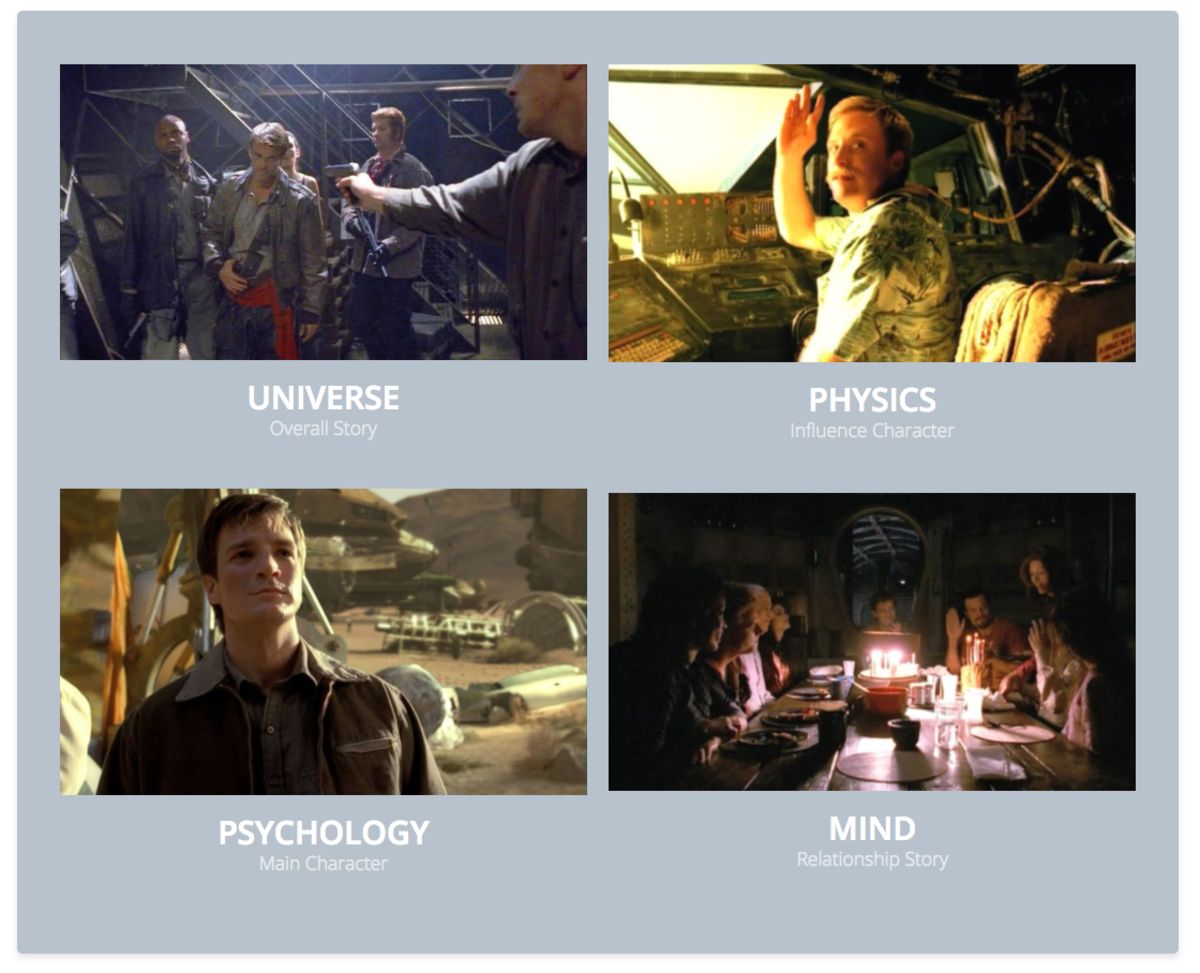
Firefly: Season 1, Episode 8
A sophisticated & complete narrative accounts for this episode's popularity.
Last night several Dramatica Story Experts analyzed Firefly: Season 1, Episode 8. Entitled "Out of Gas", this episode managed to squeeze a complete argument into the span of 45 minutes—something often reserved for films twice the running time.
A complete argument—or complete story—is an analogy to a single human trying to solve a problem. Character, Plot, Theme, and Genre simply stand in for this psychological process we all know.
Reducing the problem-solving process down to its larger pieces, one finds Four Throughlines in every complete story:
- the Objective Story Throughline
- the Main Character Throughline
- the Obstacle Character Throughline
- the Relationship Story Throughline
These represent the four different perspectives our minds take when evaluating a particular problem:
- the Objective Story looks at THEIR problem
- the Main Character looks at MY problem
- the Obstacle Character looks at YOUR problem
- the Relationship Story looks at OUR problem
In Out of Gas, "Our" problem is the Serenity family, "Their" problem is Serenity itself.
With their ship disabled in deep space and life support running out, the crew of Serenity finds themselves trapped in an unbearable situation. To add to this immediate concern, we learn through flashbacks the disparity that exists in how they feel towards one another. Some think of the ship as a family, others see it as a means to an end. The first defines the problem from an objective point-of-view, the second from a subjective perspective.
To better understand the problems we face in our lives, we classify conflict into four different areas:
- a fixed situation (Dramatica term: Universe)
- a fixed mindset (Dramatica term: Mind)
- an external activity (Dramatica term: Physics)
- an internal manner of thinking (Dramatica term: Psychology)
Complete stories assign a perspective, or Throughline, to an area of conflict. This approach ensures that we see a problem from all different sides—its why a story feels complete.
The disabled ship and dwindling life-support systems signify an Objective Story Domain of Universe. The disparity regarding how they think of one another marks a Relationship Story Domain of Mind. They see the conflict in terms of a fixed situation. We know the conflict in terms of our different attitudes.
This leaves the Main Character Throughline and Obstacle Character Throughline.
Achieving Through a Force of Personality
In a complete story, the Main Character maintains an individual preference for solving problems. Some prefer to address issues externally by taking action, others by changing themselves internally. In Dramatica, the first is a Do-er, the second a Be-er.
Contrary to his behavior throughout most of the season, Malcolm Reynolds (Nathan Fillion) prefers to adapt himself to solve problems in Episode 8. Mal tempers his personality to effect change in others, playing the role of "dad" for some and "captain" for others. To, Mal Serenity is more than a ship—it's an idea.
The amount to which the various crew members do what Malcolm needs them to do defines their Obstacle Character perspective.
A Shared Perspective of Influence
Note the use of the word perspective over Throughline. Complete stories pit perspectives against each other, not characters. The Ghosts in A Christmas Carol share the same attitude. The Joker, Alfred, Robin, and Barbara Gordon share the same perspective in The LEGO Batman Movie. Both narratives offer examples of a shared Obstacle Character Throughline.
In this episode of Firefly, Zoe (Gina Torres), Wash (Alan Tudyk), Kaylee (Jewel Staite), Inara (Morena Baccarin), and Cobb (Adam Baldwin) maintain a mutual perspective of influence on Mal. Wash brings the ship online. Kaylee fixes the engine. Cobb brings the muscle. Inara rents space on Serenity. Each of them does what they need to do to keep the ship afloat, but neither responds to the "idea" of Serenity.
Until the final climactic moment.
The Balance of Conflict
A complete story balances sources of conflict through the application of the Four Throughlines. The Objective Story Throughline finds temperance in the Relationship Story Throughline; the Main Character Throughline encounters a challenging point-of-view from the Obstacle Character Throughline.
By accounting for all four perspectives and all four areas of conflict, the Author guarantees a feeling of completeness in their final work.
Download the FREE e-book Never Trust a Hero
Don't miss out on the latest in narrative theory and storytelling with artificial intelligence. Subscribe to the Narrative First newsletter below and receive a link to download the 20-page e-book, Never Trust a Hero.


